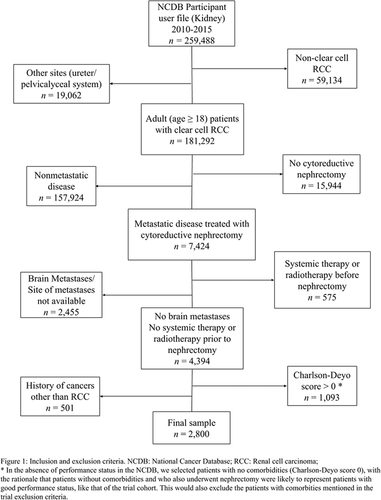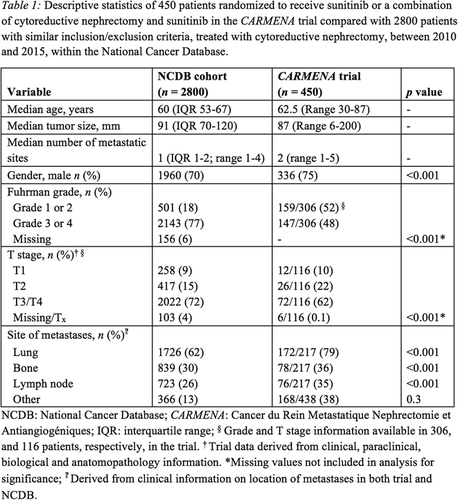Introduction and objectives:
The CARMENA phase III randomized trial reported that overall survival with sunitinib alone is noninferior to the combination of nephrectomy followed by sunitinib in patients with intermediate-to-poor risk metastatic renal-cell carcinoma (RCC). Our aim was to test the external validity of the trial in US patients.
Methods:
We identified 2800 with metastatic clear cell RCC who underwent cytoreductive nephrectomy, between 2010 and 2015, within the National Cancer Database (NCDB), and met the inclusion criteria of CARMENA trial (Figure 1). Demographic characteristics, namely, age, tumor size, number of metastatic sites, gender, Fuhrman′s grade, pathological T stage, and the sites of metastases were then compared with the CARMENA cohort.
Results:
We found that CARMENA recruited older patients (median age 62.5 vs. 60 years), with a higher number of metastatic sites (median 2 vs. 1) involved. The burden of metastasis in lymph nodes (35% vs. 26% in the NCDB), lung (79% vs. 62% in NCDB), and bone (36% vs. 30% in NCDB) was higher in the trial compared to NCDB (all p < 0.001). Interestingly, this was despite the higher tumor grade (Fuhrman grade 3/4: 2143/2800 [77%] vs. 147/306 [48%]), and higher T stage (T3/T4: 2022/2800 [72%] vs. 72/116 [62%]) in the NCDB cohort (both p < 0.001) (see table 1).
Conclusions:
Our study indicates that the CARMENA trial recruited patients with higher metastatic burden than those seen in US practice, which may have affected the trial outcomes. Our findings emphasize the role of appropriate patient selection during clinical practice, as well as during interpretation of the results of the trials on this subject.


CARMENA trial showed that in intermediate-to-poor risk metastatic-RCC, Sunitinib alone is non-inferior to a combination of nephrectomy and sunitinib in terms of overall survival. To test the external validity of this trial, we replicated the trial inclusion criteria within the National Cancer Database. We found that the trial patients had a higher number of metastases (median 2 sites vs 1 in NCDB), and a higher burden of metastases at each site. There was a discrepancy between higher metastatic burden in the trial despite the higher tumor grade, and higher local stage in NCDB. This can arguably be explained by differential exclusion of patients from the trial and highlights the need for appropriate patient selection for cytoreductive nephrectomy.